The two-day Federal Open Market Committee (FOMC) meeting starting today (Tuesday) marks a historic shift in how the U.S. Federal Reserve communicates its policy decisions with the public.
The changes center on disclosing individual FOMC members' interest-rate forecasts and economic projections. It may also release an agreed target for inflation.
"It's a significant innovation," Jeremy Lawson, chief U.S. economist for BNP Paribas, told Reuters. "It will change the interaction between the Fed and the markets and the way people think about how the Fed is likely to behave."
The main question will be if the Fed plans to give the U.S. economy another funds injection as it continues to tackle the effects of the European debt crisis and U.S. government overspending.
Here's what investors should watch for:
First-ever interest rate forecast: The Fed for the first time will release a forecast of when the United States can expect interest-rate hikes. The federal funds rate has remained between zero and 0.25% since December 2008.
The Fed in Wednesday's statement will share when individual FOMC members expect the next interest rate hike, as well as their idea of the appropriate pace for subsequent rate increases.
Analysts' consensus is that no interest-rate change will be planned until 2014 - an expectation already priced into markets.
FOMC members will also provide projections for the unemployment rate, gross domestic product (GDP), and inflation.
Republicans ready to rant: Compared to non-election years, expect much more Republican backlash after the FOMC policy statement this week.
Republican candidates like former Massachusetts Governor Mitt Romney and former House Speaker Newt Gingrich have repeatedly talked about their desire to fire U.S. Fed Chairman Ben Bernanke. Fellow candidate and Texas Rep. Ron Paul wants to abolish the Fed if he's elected.
The Republican attacks stem from the perception that the Fed has been doing what U.S. President Barack Obama wants it to do, instead of what's best for the U.S. economy.
The Fed criticism is also fueled by older Republicans who have suffered under the central bank's zero interest-rate policy. Older citizens who rely on pensions and savings are more vulnerable to inflation.
Further inflationary concerns stemming from the Fed's policy statement tomorrow will serve as campaign fodder as the Republican candidates rally support in Florida, where the next primary election takes place Jan. 31.
Fewer dissenters at FOMC meeting: Four new Fed presidents are part of the FOMC this year, following the annual rotation. The new members include Jeffrey Lacker, president of the Richmond regional Fed bank; John Williams of the San Francisco Fed; Sandra Pianalto of the Cleveland Fed; and Dennis Lockhart of the Atlanta Fed.
Gone are the three presidents who twice dissented last year on the Fed proposal to lower long-term interest rates. They feared the move would trigger more inflation.
The only hawkish president among the new members is Lacker, meaning Bernanke will likely face little opposition this year as he continues his loose monetary policy.
Time for QE3?: Though the Fed has already gone through two rounds of quantitative easing, the second of which ended in June 2011, it could be gearing up for round three.

Money Morning Global Resources Specialist Peter Krauth said last week that according to Société Générale SA (PINK: SCGLY), QE 3 could be headed our way as soon as March.
"It'll be focused on mortgage backed securities (MBS) purchases on the order of $600 billion over six to eight months - great timing to match up with the pending presidential election," said Krauth. "Markets will get a tremendous boost, bolstering support for Obama in the process."
Another round of QE3 would have a multi-asset price boost, focused on U.S. and European stocks, oil, and gold, according to SocGen.
The FOMC meeting concludes Wednesday and the rate decision and statement will be released at 12:30 p.m., followed by economic projections at 2:00 p.m. Then Fed Chairman Bernanke will address the public at 2:15 p.m. in his first 2012 quarterly press conference.
News and Related Story Links:
- Money Morning Archives:
U.S. Federal Reserve stories
- Reuters:
Fed to shed light on policy
- Marketwatch:
What's behind Republican attacks on the Fed
- Business Insider:
The New Fed Voters Are Likelier To Back A Push For More Easing


